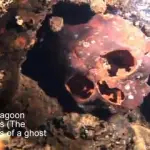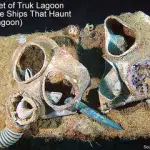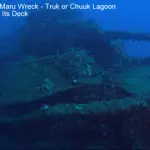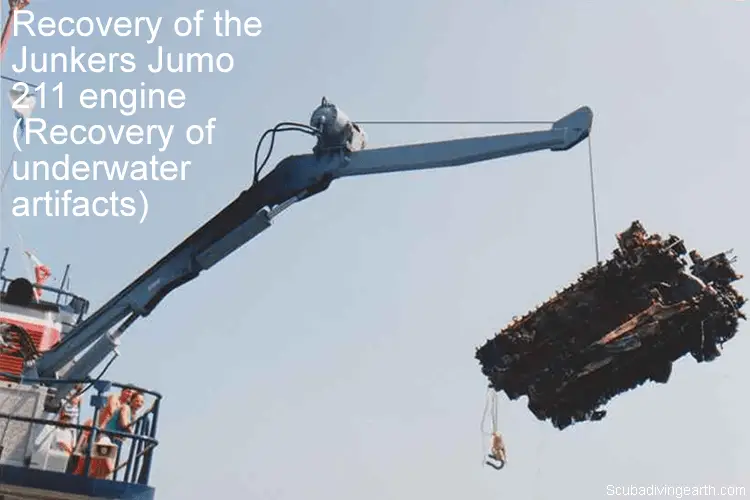
Recovery of the Junkers Jumo 211 engine by scuba diver Leslie Storace
This is a scuba diving story courtesy of BSAC Advanced Diver Leslie Storace. The story is based in Malta and is about the Recovery of the Junkers Jumo 211 engine.
A scuba diving story about the recovery of the Junkers Jumo 211 engine by scuba diver Leslie Storace. The engine belonged to a German Luftwaffe bomber that crashed into the sea during World War II. The Junkers Jumo 211 engine was mostly used in German bombers. Luftwaffe aircraft such as Junkers’ own Junkers Ju 87 and Junkers Ju 88 used this engine.
More than 70,000 of the Junkers Jumo 211 engine were made during World War II.
The best way to do more diving is to book yourself on a scuba diving liveaboard. You can check the latest and best deals on liveaboards using the following window:
Scuba diving story by Leslie Storace – Recovery of the Junkers Jumo 211 engine
“I suppose the story really began on September 1st 1991. My dive buddy John, who is a BSAC advanced diver (still is my buddy today), and I were out on our usual diving haunt by the name of (Sikka tal-Bajad).
The best translation I can give to this place is The White Reef.”
More Reading: Diving Buddy Check Acronym or Mnemonic (Why Scuba Buddy Checking Is Important)
Sikka tal-Bajad dive site – The white Reef, Malta

“The rough location of the Sikka tal-Bajad dive site is shown in the above map of Malta. It is about a sea mile from the nearest land. The dive site is at a depth of about 30 metres (100 feet). It’s quite barren for the sea floor. It’s not unlike a part of the moon with craters, trenches and small underwater caves and patches of sand. The Sikka tal-Bajad dive site a haven for fish, amongst which are large groupers.“
“It was on this day that we came upon what looked like debris dumped overboard. But something strange was very apparent. A big round thing that somehow merited investigation. This turned out to be an aircraft wheel and the tyre was still inflated.“
Underwater debris turns out to be the plane itself
“Further investigation turned out that the debris was the plane itself all broken up and many large parts were buried in the sand which sometimes exist in patches over there. I think that if it weren’t the sand that buried the plane, the current would have carried it and smashed it to oblivion.
Looking at my logbook the depth was 30.3 metres (100 feet). We stayed down there for a total of 54 mins bottom time and a 15 mins decompression.”
“On finishing the decompression, right above the crash site, we surfaced and took various land bearings with compass for a next dive. Remember this was 1991 when mobile phones were quite new and GPS position finders were things in boats and planes. Even dive computers were still primitive.”
More Reading: How Deep Can You Dive Without Decompression (No Decompression Stop Limits)

Diving the hard way and working decompression from tables
“But we learned to dive the hard way…working decompression from the tables which we carried with us, pencil and slate. Navigation was through landmarks.
I still navigate a route to nearby Sicily with compass and nautical chart. And whilst my buddy John has a 27 foot cabin cruiser, which he built himself, with 2,300 hp Suzuki motors and state of the art GPS navigation system, all it takes to get lost at sea is a battery let down.
More Reading: How do I get a dive buddy? (5 easy ways to find a dive buddy)
Today any landlubber can go to anywhere but old time seamanship is the key. Besides to be a BSAC Instructor, which I am, this is part of the course.
To continue…. I marked the landmarks and the location on my nautical chart with degrees and distance to my satisfaction and left it at that.”
More Reading: How do you do a decompression stop vs a safety stop
The next expedition to dive Luftwaffe Junkers plane wreck
“Talk of the World War II plane found by John and I in 1991 to my immediate superior Ray at the tug company raised his interest. Ray is someone whom I taught to dive.
We decided to go and give him a look see with video camera and all. On June 29th 1993, my navigation on the chart markings was spot on, allowing for 2 years of deviation and variation. We found the plane again.”
The day we discovered the Junkers Jumo 211 engine
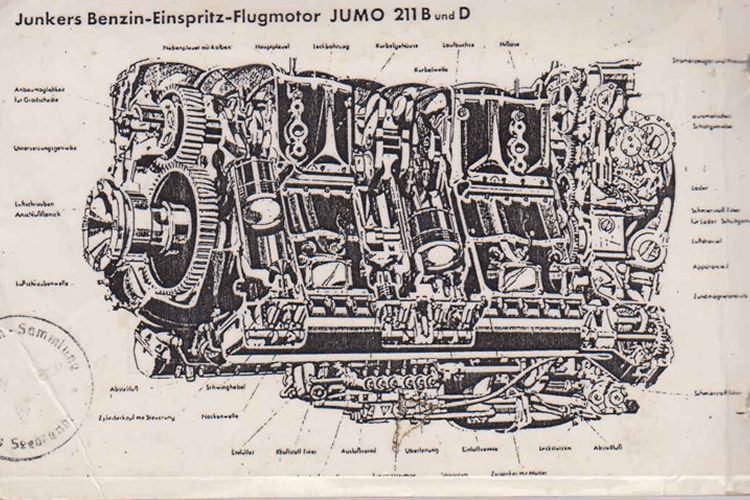
The Junkers Jumo 211 engine was a German inverted V-12 aircraft engine. This engine was an aircraft engine of World War II and a direct competitor to the Daimler-Benz DB 601.
The Junkers Jumo 211 engine was mostly used in German bombers such as Junkers’ own Junkers Ju 87 and Junkers Ju 88 Luftwaffe planes. It was also used in the German Heinkel’s H-series bomber. There were around 70,000 of these engines produced during the war, which made it the most-produced German aero engine of the war.
Back to Leslie’s scuba diving story about Junkers Jumo 211 engine
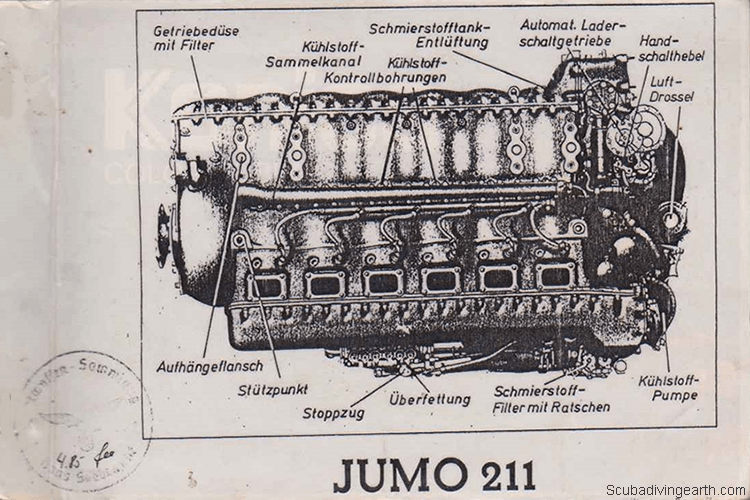
“We spent almost the same amount of bottom time at the same depth as we did in 1991, with similar decompression time. But this time we extended the search area for some other relics. It was at about 20 metres (66 feet) away we discovered the engine.
Boy oh boy what a find…it was almost as big as a large household refrigerator but by golly it looked as solid as a rock. 3 of us tugging at one light end could not even slightly nudge it, much less shake it loose from the grip of the seabed.”
More Reading: Emergency Decompression Stop vs Safety Stop (What’s The Difference?)
Planning to recover the Junker Jumo 211 engine from the sea bed
“Back on land, Ray was all excitement. Whilst being a fairly new diver it never worried me as he was a natural scuba diver. He abided by the safe diving rules I set for him to the letter for him to accompany us for that dive.
Between us we seriously planned to use a tugboat to recover the engine, to the effect that when it went higher up the ladder to the chairman of the company. We were fortunate that he gave us permission to use the tugboat. This was on the promise that we donate the Junkers Jumo to the National War Museum.”
Leslie makes an important note about the legality of the recovery of underwater artifacts:
“Many divers went on their own and recovered Roman artifacts, amphorae, WWII relics, like guns off planes etc. These could all be carried on a small boat, but it is illegal and if one gets caught he would have everything confiscated plus a fine or prison or both.
Now imagine us taking a 300 ton tugboat, a mile offshore for all to see and “stealing” an engine weighing 800 kgs. and bringing it to shore. Madness would be putting it mildly. Utterly lunatic would be more nearer the mark.”
A proud souvenir for Malta
“Whatever, we had no intention of keeping it. It was prestigious for the company to help, was prestigious to us as divers, and Malta would be proud to keep a souvenir of the deadliest destructive machine against it, in those bitter war years when the Maltese were on the brink of starvation but held on.
This is why we bear on our National Flag that King George VI gave this island nation… the George Cross for gallantry.“
Planning the recovery of the World War II artifact get’s going
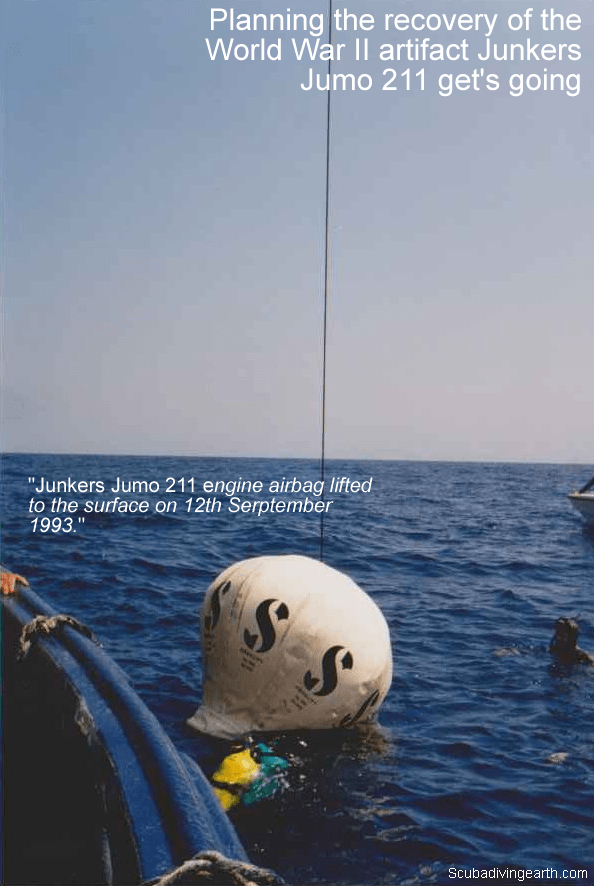
“Things got really set in motion then.
Three months later I’d had:
- Meetings with government officials;
- A meeting with the director of the war museum;
- We got volunteer crew to man a tugboat;
- Secured sponsorship from diving centres for equipment;
- We had volunteer divers;
- The dates and times to Port Control were set;
- Customs and a zillion other little things were set in place, we were set to go.
D-Day on this project was set for 29th Sept 1993
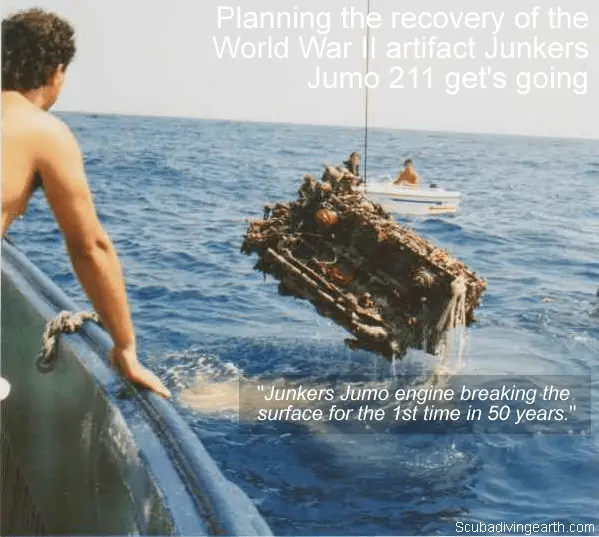
“A week prior to 29th September 1993, a team of four divers including myself went over the wreck again to analyse the situation of lifting the engine. This time though we had GPS on board and marked the spot to with an inch.
On shore a meeting was held with various entities of the government who will accompany us and the way to recover. We planned to use a 5 ton lifting bag from bottom to the surface and the tugboat’s crane from the surface to the deck.”
The day of lifting the Jumo 211 engine

“On the day in question the day was not so good and the sea was a bit choppy. Not much of a big deal for us divers and crew, having a solid tugboat underneath our feet. But most of the crew brought their wives, children, cousins, boyfriends and girlfriends of their children and more than half were seasick.
Although the master of the tugboat had the full responsibility I, as the supreme leader of the dive team and the project, had a talk with him to go to nearest shore and put them back on land. This was at least until after the operation, as I refused to dive with people sick on board. We had already broken a maritime law by not letting them wear life jackets, so I was adamant. This he did and the dive began.”
Crystal clear visibility helped on the day of lifting
“Now prior to this, we had painted the first 10 shackles of the tugboat’s anchor white to be used as reference for us underwater. The sea was crystal clear and we could see the shackles from a distance away. We then started to attach the bag with chain and strop to the engine and fill the lifting bag with air.
Now here experience is needed, for when the lift begins a diver (which in this case was myself) has to rise up with the bag and release air slowly as it rises. Otherwise the expanded air either tends to tear the airbag or if it holds it will fly up, especially near the surface.
“The bag was doing its job alright. It was a good thing that we had brought a 5 ton lifting bag, for we nearly filled it before the engine began to feel the pull. It was truly embedded.”
More Reading: Boyle’s Law Scuba Diving (Diving Physics For Dummies)
Strops snap and the engine drops back to the seabed
Just as the engine was starting to lift, the strop attached to the engine and the airbag chain snapped. The engine fell back with a thud and the air bag shot off like a rocket. The thud of the engine stirred the bottom to a murky soup. To crown it all, I could not see the white shackles of the tug’s anchor.
Hell’s bells, I had to decide quickly. Down I went to the other divers, and on my slate I told them that first I am going to look for the tug on the surface and they were to stay put.
They let up their surface marker buoy up, so the tug boat could see where they were from the surface. It was important they didn’t compromise their decompression, but if this looked likely, they were to surface and we’d abandon the dive.”
More Reading: 12 Decompression Sickness Risk Factors In Scuba Diving and How to Avoid Them
The boat’s anchor wasn’t far way
“As things turned out, the tug had dragged its anchor a bit and was not too far away. The boat master had seen the jettisoned air bag shoot out of the water. He realised what happened, but was afraid to turn the engine on just in case we were right underneath.
I swam closer to the tug boat and shouted that we are all ok, explaining to keep a look out for the marker buoy at all times. I further explained that I would try to take the now deflated bag back down to the Jumo engine once more.”
Clearer thinking and diver safety came first
“It was rashful thinking through disappointment. On second clear thoughts I told the master of the tug to recover the air bag himself. With the help of the crew, this is what they did. This enabled me to go down to let the other divers know and to surface.
We left the engine on the seabed, but with the marker buoy tied to the it.”
Back on the tug boat for a debrief and a chat – the second recovery attempt for the Junkers Jumo 211 engine
“With all of us back on the tug, we had a talk. With the air bag recovered and folded neatly again, we had to decide whether we try a second attempt. The tug had spare strops, and we had spare air cylinders. The engine was now free of the seabed suction and it should not be as hard as at first. All of us were experienced divers and we all voted for a second attempt.
This we did…all the repetition of the first dive. This time though we used 2 strops, and the engine lifted like a baby from a cradle…very gently. We all went up with it to the surface, with me letting the air out and a diver keeping an eye on me just in case. The Junkers Jumo 211 engine finally broke the surface for the first time in 50 years.”
The Junker Jumo 211 engine safely out of the water after 50 years
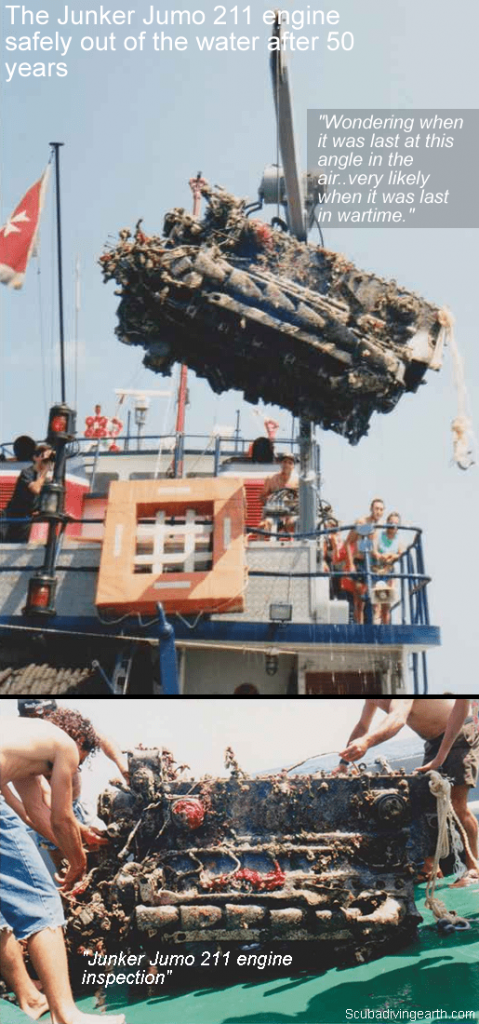
Junker Jumo engine 211 lifted out of the water, cleaned and sand blasted

“The engine was lifted out of the water with the tug’s on board crane. We then climbed on board to hearty congratulations from all present.
We then went to pick up the crews families, and then sailed to a quiet safe beach to have a barbecue aboard the tug.”
Back to Valletta, Malta
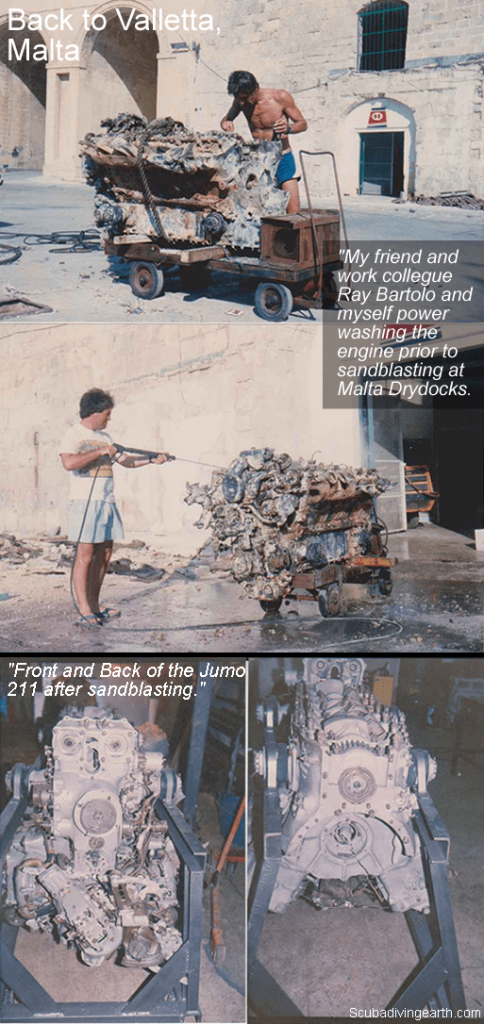
“Very late that afternoon we sailed back to Valletta. We placed the engine in the tugboats warehouse. The next days that followed Ray and I cleaned and sand blasted the engine to almost new. It was then presented to the Malta’s Valletta National War Museum where it still is today.”
More Reading: My Great White Shark Story In South Africa (But Didn’t Get To Dive With It)
I hope you enjoyed this scuba diving story about the recovery of the Junkers Jumo 211 engine
Thank you to Leslie Storace for providing this great scuba diving story about the recovery of the Junkers Jumo 211 engine.
I hope you enjoyed this story as much as I did. If you did, I’d love to hear from you. Plus I’m sure Leslie would like to hear your thoughts and comments too. If you also have a great scuba diving story you’d like to share, please get in touch. You can put your details in the boxes to the right or below this article where it’s headed: “Send your scuba diving short story”.
Your comments of questions
Also, please take time to tell us about your adventures of diving and snorkeling, in the comments below. Please also share your photos. Either from your underwater cameras or videos from your waterproof Gopro’s!
If this article hasn’t answered all of your questions. If you have more questions either about snorkeling or scuba diving (or specifically about a scuba diving story about the recovery of the Junkers Jumo 211 engine), please comment below with your questions.
There will also be many more articles about scuba diving (and snorkeling) for you to read and learn about these fabulous sports.
Have fun and be safe!


